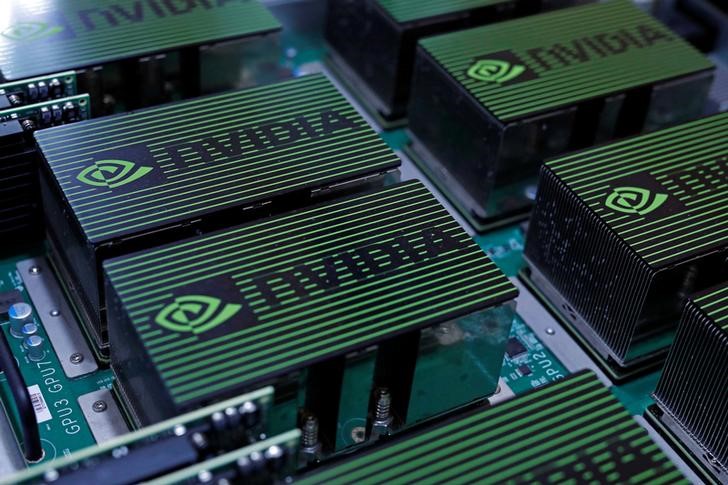DENVER - NVIDIA (NASDAQ:NVDA) announced advancements in Universal Scene Description (OpenUSD) aimed at broadening its use beyond creative industries to sectors such as robotics, industrial design, and engineering. These enhancements, built on the NVIDIA Omniverse platform, are designed to facilitate the creation of accurate virtual worlds and digital twins, essential for the next generation of AI and robotics.
The new offerings include NVIDIA NIM microservices, which utilize OpenUSD language to streamline digital twin development. These microservices can generate OpenUSD Python code, apply materials to 3D objects, and comprehend 3D space and physics. Moreover, NVIDIA has introduced USD connectors for robotics and industrial simulation data formats, as well as developer tools for streaming datasets to Apple (NASDAQ:AAPL) Vision Pro.
NVIDIA's vice president of Omniverse and simulation technology, Rev Lebaredian, highlighted the expansion of digital worlds into various industries, noting that the NVIDIA NIM microservices will democratize the development of virtual factories and other applications.
The world's first generative AI models for OpenUSD, developed by NVIDIA, will be available as NVIDIA NIM microservices. These models are designed to assist developers in incorporating generative AI into USD workflows, potentially transforming 3D world interactions across new industrial sectors.
Foxconn (SS:601138) and WPP (LON:WPP) are among the early adopters of NVIDIA's computing platform and NIM microservices. Foxconn is creating a digital twin of a developing factory, while WPP is implementing USD Search and USD Code NIM microservices in its AI-enabled content creation pipeline for clients like The Coca-Cola Company (NYSE:KO).
NVIDIA's collaboration with Siemens aims to integrate OpenUSD pipelines with Siemens' Simcenter simulation technologies, enhancing decision-making and collaboration. This integration is expected to provide deeper insights into product performance within real-world environments.
In line with fostering OpenUSD ecosystem growth, NVIDIA announced the OpenUSD Exchange software development kit, which allows developers to create their own OpenUSD data connectors.
The USD Search, USD Code, and USD Validate NIM microservices are currently available in preview on the NVIDIA API catalog. Developers can access new tools and a reference workflow for integrating generative AI into OpenUSD workflows via the Omniverse platform.
This expansion of OpenUSD capabilities is based on a press release statement from NVIDIA and reflects the company's ongoing efforts to advance 3D data interchange frameworks across various industries.
In other recent news, NVIDIA has launched new tools to expedite humanoid robot development, including the NIM microservices and OSMO cloud orchestration service. These tools, now available through the NVIDIA Humanoid Robot Developer Program, aim to significantly cut development cycle times.
Meanwhile, Taiwan's Q2 economic growth, despite a slowdown, was largely supported by a surge in artificial intelligence (AI) technology exports, with Taiwan Semiconductor Manufacturing Co. playing a crucial role. Analyst Kevin Wang highlighted the strong momentum from AI-related products.
In China, despite broader economic challenges, industrial profits rose by 3.6% in June, marking an acceleration from May's 0.7% increase. Notably, suppliers to NVIDIA, Zhongji Innolight and Suzhou TFC Optical Communication, are expecting substantial earnings increases due to the global expansion in AI technologies.
Finally, Wall Street experienced a significant selloff, particularly affecting tech stocks. However, Keith Lerner, co-chief investment officer at Truist Advisory Services, maintains a positive long-term view on tech stocks, suggesting that the long-term bull market trend remains intact. These are recent developments in the tech industry.
InvestingPro Insights
In light of NVIDIA's recent advancements in Universal Scene Description (OpenUSD) and the expansion of its Omniverse platform, investors may find the company's financial and market performance particularly interesting.
According to real-time data from InvestingPro, NVIDIA (NVDA) has shown remarkable revenue growth over the last twelve months as of Q1 2025, with an increase of 208.27%. This growth is indicative of the company's strong position in the market and its ability to capitalize on emerging technologies.
Another notable metric is NVIDIA's high P/E ratio, which stands at 64.66. This suggests that investors have high expectations for the company's future earnings potential, possibly reflecting confidence in NVIDIA's strategic initiatives such as the expansion of OpenUSD capabilities. Additionally, the company's Price / Book ratio is at 55.8, emphasizing that the stock might be trading at a premium due to its robust growth prospects and solid market position as a prominent player in the Semiconductors & Semiconductor Equipment industry.
InvestingPro Tips for NVIDIA also highlight that the company has maintained dividend payments for 13 consecutive years, which could be a sign of financial stability and a commitment to returning value to shareholders. Moreover, NVIDIA's stock price movements have been quite volatile, which may be of interest to investors seeking dynamic trading opportunities.
For those looking to delve deeper into NVIDIA's financial health and market performance, there are additional InvestingPro Tips available at Investing.com/pro/NVDA. These tips include insights into the company's profitability, debt levels, and valuation multiples. To access these insights and more, readers can use the coupon code PRONEWS24 to receive up to 10% off a yearly Pro and a yearly or biyearly Pro+ subscription. Currently, there are 20 additional InvestingPro Tips listed for NVIDIA, which can provide a more comprehensive understanding of the company's investment profile.
This article was generated with the support of AI and reviewed by an editor. For more information see our T&C.
